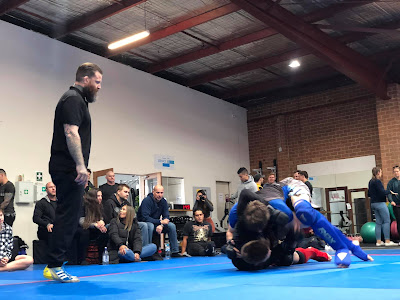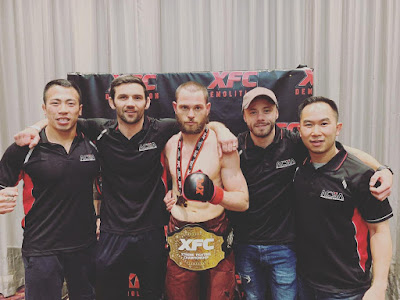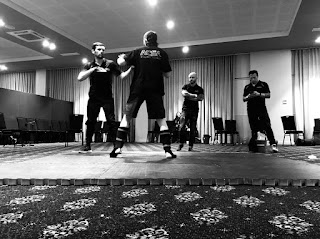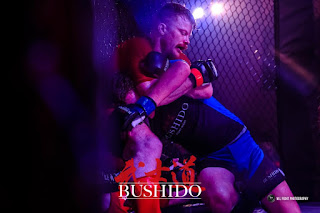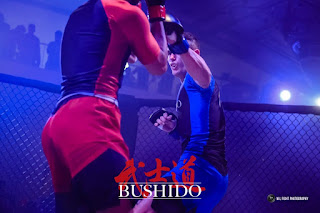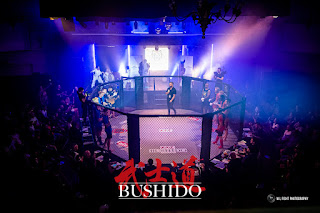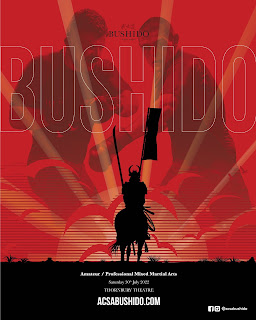InFocus Interview
Tuesday 23 June 2020
InFocus Video Interview with Will Luu
InFocus Interview
Thursday 28 November 2019
Advice for MMA Fighters - MMA Melbourne
As a coach, one of the worst things a fighter can do is to train hard in the lead up to a fight and then quit training straight afterwards. This is even worse when the fighters teammates also have upcoming fights to prepare for. It is very unlikely the coach will be prepared to put the same effort into training the fighter in the future if he knows they lack commitment. Another side of this is to not chop and change your training every couple of weeks, stick with what has been getting you results and gradually increase the volume and intensity of your training.
At the elite levels of any sport, every player is playing injured all the time. Get used to it, strap up your injured knee, elbow or foot and keep going. Select different exercises or techniques that won't exacerbate the injury but avoid taking time off at all costs. If training consistently to achieve your goals is important to you you will find a way to make it happen, if it's not important you will find an excuse.
The amount of extra training you'll get done by not working will usually end up not being worth it. Most gyms and martial arts schools do most of their training outside of work hours. Even if you quit your job in order to train full time most of your training partners will be at work.
Focusing on only one area at the expense of other skills will leave holes in your game which will be easily exploited by more experienced future opponents. Competing in other combat sports such as BJJ or amateur Kickboxing is a good safe way to gain valuable experience and develop your skills so that you are more well rounded and more of a threat when you fight in MMA.
Check out our MMA Classes at ACSA MMA & BJJ Melbourne
Tuesday 12 November 2019
Our first Amateur MMA Promotion - MMA Melbourne
We've been planning to run something like this for years and now finally felt the time was right. Over the years of training fighters we always felt that there were very limited opportunities for fighters to develop and get suitable competition experience in a way that prepared them for success in MMA.
The number one aim for our event was to provide a good avenue for fighters to gain competition experience in a way that would benefit them later in their fight career.
We were all very happy with how well the event ran and everyone who took part really enjoyed it and had great reviews,
Some of the things we focused on to make our event work well included.
A modified ruleset with No headshots. We were very clear about this in the lead-up and in the rules meeting before the matches. This rule-set is safer and means fighters can have several matches on one day. of course, it's going to feel different to fighting with headshots but the point is that fighters can gain valuable experience fighting under these modified rules that will serve them well when they do eventually progress onto fighting in pro-MMA rules,
We had several Fighters and Coaches say that they felt they would be at a disadvantage because they come from a kickboxing background and need to be able to strike to the head. In my opinion, the point isn't to win every match at this very early stage of your career. It is much more beneficial in the long term to gain valuable experience early in your competitive career and become a more well rounded and skilled fighter so that you don't get exposed later on in your career when the stakes are much higher.
I've always believed that the best career path for the long term athlete development of an MMA fighter is to compete in Grappling or BJJ tournaments as much as possible, compete in around 5 to 10 Amateur Boxing or kickboxing fights, compete in as many amateur (No headshot) MMA events as possible, then move on to Amateur MMA with head strikes and after 10 amateur MMA matches then you can fight under professional rules.
I believe this sort of long term plan is very important because too many fighters try to rush into pro rules MMA and then hope to learn on the job.
Finally, we spent a lot of time making sure the format for the day was well organised and scheduled so there wasn't too much waiting around and less confusion about what's happening when. This, in turn, leads to less nerves for the fighters and overall and more enjoyable.
Overall ACSA Bushido #1 was a great success and we are already looking forward to running the next event on Saturday 1st February 2020.
Thanks again to everyone who helped out as judges, referees and staff. Thanks to all the fighters and teams who came along to take part and thanks to all the spectators who came along to support, Hope to see you all at the next one.
Monday 21 October 2019
ACSA MMA Fighter Mitchell Carter wins the XFC Title - MMA Melbourne
This weekend my student Mitchell Carter won the XFC Amateur Featherweight Title. XFC is the longest-running MMA promotion in Australia and this was their first-ever event in Melbourne.
Mitchell has been training hard as part of our MMA fight team and has won four MMA fights, one Boxing match and a NOGI Jiujitsu tournament in less than a year.
In the leadup to this title fight, Mitchell put in a solid eight weeks of preparation focusing on his takedown and wrestling skills as well as adding some new tools to his striking arsenal.
He actually had three changes of opponent for the fight due to injuries and pull-outs. His eventual opponent was a very good, experienced striker who Mitchell fought once before. The end result was a great fight and a good clash of styles.
Thanks to everyone on our team who helped out in the preparation in the weeks leading up to the fight. How a fighter performs on the night of a fight is a direct result of the training partners who he has trained with day in and day out over the weeks leading up to the fight. We are very lucky at Australian Combat Sports Academy to have so many great strikers and grapplers all training together under one roof in a safe environment that allows us to get great results like this.
Monday 14 October 2019
The Importance of Amateur MMA - MMA Melbourne
The Importance of Amateur MMA - MMA Melbourne
One of the biggest problems I see with aspiring fighters is that they are in too much of a rush to fight Pro. If you intend to have a successful long term fight career it is essential to gain as much experience as possible as an amateur. Generally, you will only get one shot at a contract with a major promotion such as the UFC so it's important that you are close to being the finished product when you get there rather than hoping you'll improve once you get there.
Monday 30 September 2019
ACSA Bushido Amateur MMA - MMA Melbourne
We are running our first ever amateur MMA event at our Australian Combat Sports Academy on Saturday 9th November. There will be no head strikes allowed (standing or on the ground) and will be round-robin format so everyone will get a few matches on the day.
This format will be a good first step for beginners who are looking to eventually compete in MMA but also just for martial artists of various backgrounds to try it out and test their skills under a compromised rule-set.
I believe that no head strikes is the best rule set for beginners to try out MMA. It's a great way for aspiring fighters to gain valuable match experience without the unnecessary risk of injury. I personally competed in many of thees types of matches in the UK in the early 2000s alongside future UFC stars such as Michael Bisping.
Here is the link to register:
https://www.eventbrite.com.au/e/bushido-amateur-mma-competition-tickets-72835722607
Kicks and Knee Strikes to the Legs
Punches to Body and Kicks to Legs are allowed when Opponent is in the downed position.
All throws and Takedowns
All Arm-locks and Shoulder Locks
Chokes and Strangles Excluding Neck Cranks
Leglocks Excluding Heel Hooks
No strikes of any kind permitted to the head.
No Slamming of opponent either as a result of a takedown or to escape a submission.
No Neck Cranks or Heel Hooks.
No Standing Submissions.
A fighter will receive Warning: Two warnings leads to Disqualification
No Grabbing Opponents clothing or Shin-guards, gloves or Knee-pads.
No running out of the competition area.
MMA Shin Guards
MMA Knee Pads
Mouth Guard
MMA or Muay Thai Shorts
One fighter has taken too many unanswered strikes from any position.
One fighter is in a locked-in submission but is refusing to tap and is risking injury.
Submission via Tap Out due to Strikes.
Technical Knockout due to strikes either in Standing or Grounded position.
Referee Stoppage
Judges Decision
Disqualification
Effective Striking - Strikes that have an immediate or cumulative impact with the potential to end the match.
Effective Grappling - Takedowns, submission attempts, reversals and the achievement of advantageous positions that have an immediate or cumulative impact to end the match.
A successful takedown is not just a changing of position, but an attack from the use of the takedown.
Submission attempts taking considerable effort to escape are given greater weight than those that are easily defended and escaped without effort.
Impactful throws and takedowns are weighted more heavily than athletes who are tripped or bundled to the mat.
Tuesday 12 February 2019
Deliberate Practice
Monday 4 February 2019
The Four Stages of Learning Martial Arts
Monday 21 January 2019
My MMA Journey - Part 3
After my win in Italy at the end of 2003 I was keen to get back in and have another go as soon as possible. Unfortunately, there weren't as many opportunities to fight or MMA events taking place at that stage. I kept myself busy by competing in BJJ, KSBO amatuer MMA events and also some Jiu Jitsu Kumite events which were mixture of semi contact karate and grappling. I was also pretty busy at this time with work and exams, but as soon as my exams were over I made a big push to get matched up for as many MMA matches as I could get.
I had four pro MMA fights in four months from June to September 2004. I won three of those and the fourth was given as a draw however it was one of my most dominant ever fights. I took my opponent down and punched and elbowed him from guard for three straight rounds. In between these fights I also competed in regularly in BJJ and grappling events.
I found all my own matches by contacting promoters and offering to fight anyone they had at a similar weights. Then a group of us would head off on a road trip on Saturday to the other side of the country. Weigh in, have a fight then drive home later that night. Looking back now that probably wasn't the best way to manage a Fight career but I wanted to keep improving and to me that meant testing myself and staying active. I had to fight whoever was offered and keep working to get better between every fight.
Throughout all these fights and during the training camps I was suffering from instability in my knee. I could still and compete but it would pop out every now and again (including during one of my fights) and I needed to keep it heavily taped up when I fought. At the end of 2004 I was booked in to get ACL reconstruction surgery and this put my fight career temporarily on hold.
In Feb 2005 I had a full ACL reconstruction. This can usually take a long time to recover from but I wanted to make sure I was fight ready as soon as possible after the surgery. The first two weeks I was off work stuck at home wearing a huge knee brace and using crutches, as soon as I could walk again I got back to light weight training and also did rehab physio sessions once a week. About a month after the surgery I got back to boxing, however focusing more on punching and not so much footwork. During this time I did most of my boxing training at the Fitzroy Lodge gym in south London.
I also had more exams around May of this year so once my exams were done I wanted to return to full training. Approximately five months after my knee surgery I was ready to get back to grappling training and was able to compete in a grappling tournament again a few weeks later.
Around this time I also got offered a shot to fight on a new MMA promotion which would take place in London in October. I was very keen to get back in and fight to make up for my lost time. In the months leading up to this fight I also went on two training trips, firstly to Amsterdam where I got to train with many legends of Dutch Kickboxing including Ernesto Hoost, and then a few months later I traveled to Brazil where I trained at Brazilian Top Team, which was the leading MMA team in the world at that time.
My first fight back after surgery was against Ciro Gallo in York Hall, Bethnal green. I dropped him with a punch right at the start of the round then got a Judo style Turtle rolling armbar. I was happy with the result of this fight as I had been out of full training and fighting for so long. However as always when I felt a fight was too easy I also had a slight feeling of disappointment that it wasn't enough of a challenge and that I had wasted several months of training and preparation but hadn't really tested myself. However I was never really the type of fighter to pick and choose my opponents or even to bother finding out much about them before i stepped into the ring. I just fought whoever was in front of me. I didn't look as MMA fighting as a career or even a sport. I just looked on it as a realistic way of testing my martial arts skills. If you get attacked on the street you don't get to pick and choose who you get attacked by, you don't ask for someone who is closer to your weight or has a similar record and you certainly don't ask your attacker to come back on another day because you've got a cold or sore elbow.
Monday 9 July 2018
What I've learned as an MMA coach
You don’t need to be a Fighter.
Before becoming a coach I believed that I needed to gain as much fight experience as possible. In my mind it would affect my credibility if I hadn't been there and done it. Since opening my school I've never had a single student who cares if I had real fight experience or not. The only thing that students care about is whether you will be able to help them achieve their goals. Fight Experience can be useful and is helpful for separating the legitimate coaches from the frauds but many experienced fighters are clueless when it comes to coaching and don’t take the time to learn how to coach properly.
No Substitute for Experience.
However, my own fight career has been a useful asset for me. My experiences in the ring and cage have given me confidence in preparing fighters and an ability to understand what they are going through during their preparation. I can help my fighters avoid making the mistakes that I made during my fight career. This speeds up their learning and progression rather than relying on trial and error. I am also confident that I am not asking my fighters to do anything that I haven’t done myself. Trustworthiness is one of the most valuable attributes a coach can have. The fighter must be able to trust the coach 100% rather than doubting if he is actually speaking from experience.
Wide Knowledge Base.
What you learnt during your own training and fighting won’t be enough. Every Fighter has their favourite techniques that have worked well throughout their competitive career. When you start coaching you encounter a wide variety of students of different skill levels, personalities and body types for whom these techniques just aren’t a good fit. Students will get bored of learning your ‘A game’ every night for the next five years. You need to go back and re-learn many techniques and skills that you didn’t pay too much attention to when you were a fighter. You need to understand them so you can pass them onto your students. You also need to invest time in learning how to coach properly and be aware of the distinction between demonstrating how much you know versus passing on the information in a useful manner.
Always Keep Learning.
Don’t keep looking back to the glory days. MMA is continually getting better and more advanced and a good coach needs to keep learning and improving. Some martial arts styles haven’t changed much in the past 50 years however MMA and BJJ are continually evolving and changing, A good coach must keep up to date with new techniques so that students are not caught off guard by them, Too many coaches rely on just teaching the way they were taught. All sports evolve and improve over time and combat sports are no different. It makes sense to continually stay on top of the latest developments in the sport just as an athletics or football coach would.
Martial Arts Trends come and go.
There will always be new fads or new trends in the industry. Since gaining popularity in the western world Martial Arts has a history of going through trends where one style would be popular for a few years and then replaced by another. This was the case with Judo, Kung Fu, Karate and then Ninjitsu. MMA & BJJ are currently the biggest trend in the martial arts world. BJJ is actually a microcosm of this Martial Arts trend phenomenon where we see a new group of techniques become popular for a few years before being replaced by something else. Based on this I believe you need to be aware of the current trends in the industry but focus on the term long term rather than basing your entire coaching philosophy around whatever happens to be popular at the moment.
The Right Culture and Training Environment.
As mentioned previously, a good coach must stay on top of the latest developments in in the sport, however, Trends come and go. What is relevant and popular this year may soon be seen as an old fashioned technique that nobody uses anymore. What can persist for a much longer time is the gym culture that you create. The atmosphere and culture in your gym is the most important asset. How the students and fighters act, treat each other and behave in the gym. The training environment you create in terms of safe and effective training, and the reputation and the values of the team are more important than short term success.
Coaching Beginners is more Impressive than Coaching Champions.
Anyone can coach a fighter who is already a champion. By the time they reach Championship level the fighter should already have spent ten thousand hours training. It becomes more a matter of supervising their training and making sure they don't do anything stupid. What impresses me most is when a coach can take a complete beginner with no skill or training background and get them to championship level.
The Team is more Important than the Individual Fighters.
Obviously it is always more rewarding to work with a fighter from beginner level all the way up to championship level but this is not always possible. Fighters will switch gyms, lose interest in fighting or quit training altogether but its not a big deal. Every top level professional sports team has players leave every season, every college or high school has to start off each year with a fresh batch of players. If the right systems, culture and coaching are in place then the team will consistently produce results.
Focus on Quality over quantity.
Some people aren’t a good fit and will do more harm than good. Many coaches think that the more people they can ram into their classes or fight team the better. One bad training partner with the wrong attitude can put off (or Injure) five or six people. The same is true with building the long-term culture of the Gym. Some fighters will bring with them bad habits such as turning up late, missing classes or lazy training. If you don’t stamp it out this will eventually rub off on other junior members of the team, who will follow the lead of the senior fighters, develop the same bad habits and ultimately lose any chance of achieving their full potential. No matter how much talent a fighter may potentially have, if they don't fit with your team culture and philosophy you are better off without them.
There are no secrets.
Fighters often feel like they are missing out if they aren't training with ten world champions every day. I've trained at some of the best gyms around the world and with many of the top coaches. What I've learnt is that there really are no secrets. The most successful gyms and fighters just do the same things that everyone else does, they just do more of it and do it more consistently.
It's about more than just Winning Fights.
Training fighters to win trophies and belts is great but the novelty quickly wears off. This is especially true if you feel that the competition success isn’t having a positive effect on the fighter or the team. There are too many examples of fighters and athletes who were successful in competition but the success had disastrous consequences for their life outside of sport. Martial Arts should be a way of improving the lives of everyone involved rather than focusing on winning at all costs.
Wednesday 6 June 2018
The most important fights in MMA history
The history of Mixed Rules Fights
The Background of this Fight
Breakdown of the fight:
The importance of Ground-fighting:
The Secret to the Success of Brazilian Jiu Jitsu
Levels of Sparring
Tuesday 29 May 2018
Martial Arts Injuries
I've found that the majority of students can be trusted to roll or spar safely without any problems and without causing injuries. I've also noticed over the years that most of the injuries in sparring usually come form 20 percent of the students. If you're the coach I think it's a good idea to monitor the sparring and look out for those 20% of students who are constantly going too hard, being too competitive or using too many risky or unorthodox techniques. Take them aside and encourage them to tone it down or join up at the new gym down the road instead. You’ll be amazed how the injury rate goes down once you get rid of the ten ‘win at all costs’ students. Then the rest of your students can train in a safe and productive environment.
Long Term BJJ Training
Eleven years ago since I got my black belt and I thought this would be useful advice for anyone who is in the earlier stages of their JiuJi...

Popular Posts
-
We have two great seminars coming up soon: On Thursday 7th February we have Alex Volkanovski and Frank Hickman for an MMA Wrestling Semi...
-
Why do some people succeed with their Martial Arts training while others never get anywhere? Over the years of running our gym I...
-
Why do some MMA fighters have successful careers while others start off well but then quickly go downhill? I’ve seen fighters have a lo...


